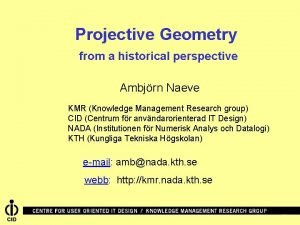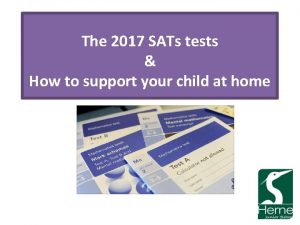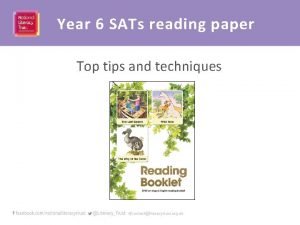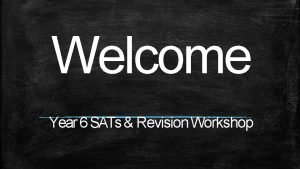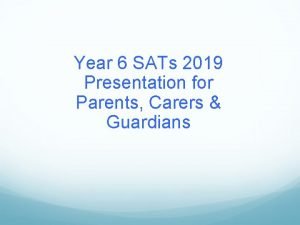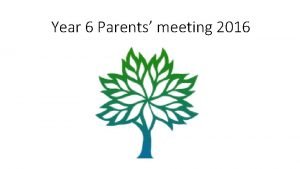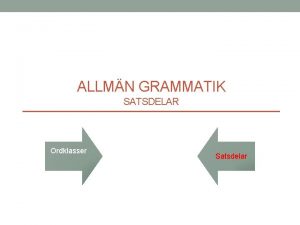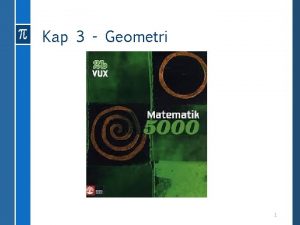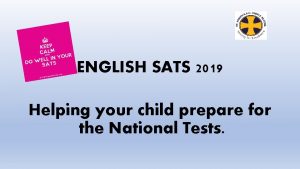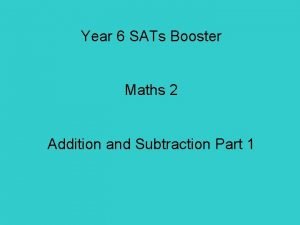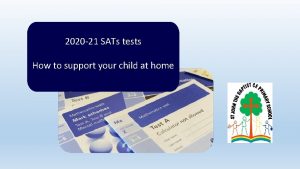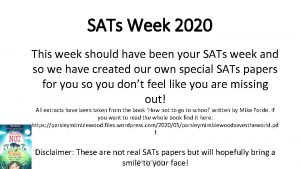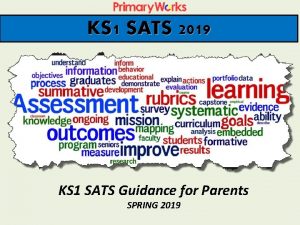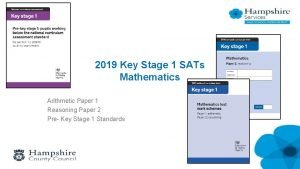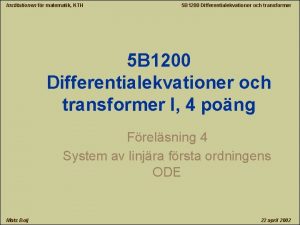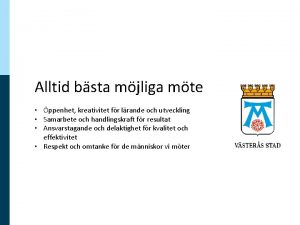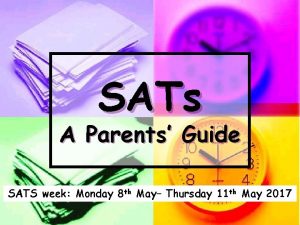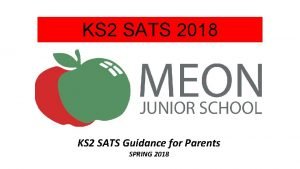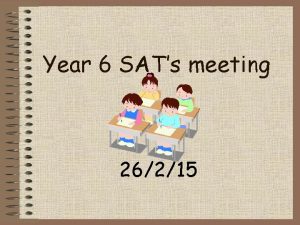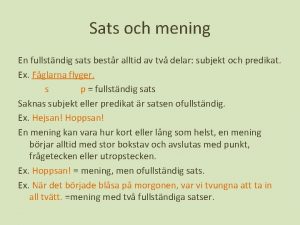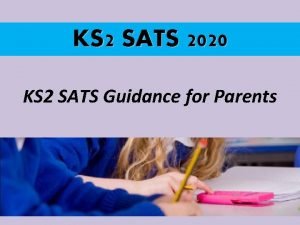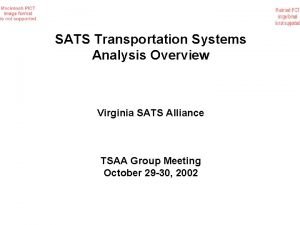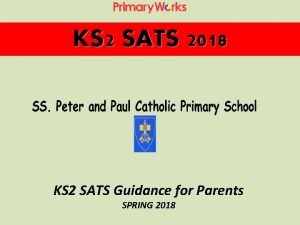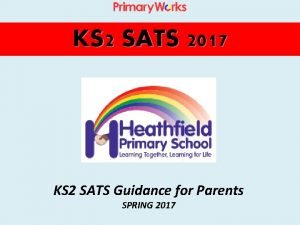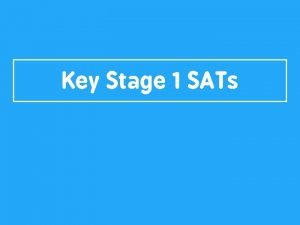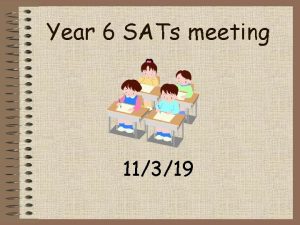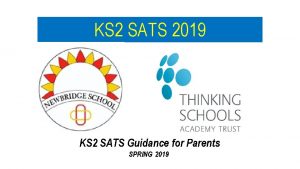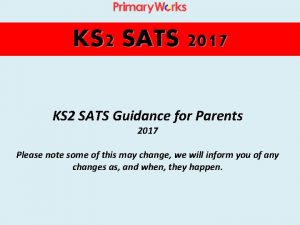KS 2 SATS GUIDE What are SATs SATs
















- Slides: 16

KS 2 SATS GUIDE

What are SATs? ◦ SATs are the statutory end of Key Stage assessments in Reading, Maths and SPAG (spelling, punctuation and grammar). ◦ They are designed to test the children’s knowledge and to give a measurement of attainment and progress for the school. ◦ They are sat by all Y 6 children in the country at the same time and the results are then reported to school and parents. ◦ Writing is also measured but in school using a framework set by the government.

When are they? ◦ The week beginning 14 th May ◦ There will be tests each day from Monday to Thursday according to a set timetable. ◦ School can decide when each test is taken on each day between 7 am and 7 pm. ◦ Polruan will set the tests on the morning of each day. 14 th May Spelling, punctuation and grammar 1: Questions 15 th May Reading 16 th May Maths 1: Arithmetic Maths 2: Reasoning 1 Spelling, punctuation and grammar 2: Spellings 17 th May Maths 3: Reasoning 2

What do the tests look like?

Reading ◦ This test is 60 minutes long and tests the childrens understating and comprehension. ◦ There will be 3 separate texts and questions that relate to each of them will be asked. ◦ Questions include choices of layout, vocabulary, text features as well as comprehension. ◦ The questions can be multiple choice or longer written explanations. ◦ Teachers CAN: ◦ Read the instructions and re-phrase these for understanding. ◦ Teachers CAN’T: ◦ Read any part of the text apart from the instructions.

Maths 1: Arithmetic ◦ This test is 30 minutes long and consists of a series of mathematical calculations. ◦ The children cannot use calculators, tracing paper, squared paper or other mathematical equipment. ◦ The questions will get harder as the test goes on to test greater depth of understanding. ◦ Teachers CAN: ◦ Read words and numbers. ◦ Teachers CAN’T: ◦ Read specific mathematical symbols. ◦ Indicate if an answer is wrong or right.

Maths 2 and 3: Reasoning ◦ These tests are both 40 minutes long. ◦ They are designed to test the children’s understanding of maths through longer questions and worded problems. ◦ The questions are set in context and the children will need to decide how best to solve them. ◦ Children can use rubbers, rulers, protractors and mirrors and are encouraged to cross out mistakes rather than rubbing them out. ◦ The scores of the 3 maths tests are added together to give a total. ◦ Teachers CAN ◦ Read the words and numbers of a question. ◦ Teachers CAN’T ◦ Read mathematical symbols or explain what is needed to solve the question.

SPAG 1: Questions ◦ This test is 45 minutes long and is designed to test the understanding of grammar, puntuation and vocabulary of the English language. ◦ There are some multiple choice questions and some short answer questions. ◦ Teachers CAN ◦ ◦ ◦ Explain words to help understanding of the context: What a jumper is or Anif is a name. Read the question in a neutral tone. Read bold words with emphasis Read sentences with blanks, saying the word ”Blank: Rephrase questions without changing subject-specific guidance. ◦ Teachers CAN’T ◦ Explain subject-specific words such as “Determiner”. ◦ Read sentences with multiple choice answers inserted. ◦ Read with pauses if a question asks to insert missing puncutaion.

SPAG 2: Spelling ◦ ◦ This test is about 15 minutes long and is designed to test the understanding of the children’s spelling. The score for this test is added to the SPAG 1 test to give a total. The teacher will read out a word, then repeat it in a sentence and then repeat the word again. The children are expected to write the correct spelling in a gap on their paper. ◦ Teachers CAN ◦ Read the word 3 times following a prescribed format. ◦ Teachers CAN’T ◦ Pause in their reading. ◦ Spell any word out. ◦ Emphasise any sound or phoneme.

How are the tests carried out? ◦ They all take place in a room with any displays covered. This will be Tolbenny at Polruan. ◦ There will be 2 members of staff to collect the papers and open them in front of children in the test area. The only exception to this is if a paper has been copied onto coloured paper. ◦ The children will put their legal full name, date of birth, school name and Df. E number on the front of each paper. ◦ The staff will read the instruction pages to the children and answer any questions they may have (and are able to). ◦ The children will sit the test for the appropriate length of time. ◦ The tests will be collected in silence and secured by the members of staff.

Specific Support ◦ Breaks can be given at any time during the tests. ◦ The clock must be stopped and a note made of the time. ◦ Children MUST NOT discuss the test during the breaks. ◦ Extra time can be given to certain children in all tests. This is based on teacher assessments and a very stringent set of Df. E guidelines. ◦ Transcriptions (copies of what has been written) can be used if it will be difficult for a marker to read the tests. ◦ These are done at the end of the test with the pupil before they leave the room. ◦ The answers cannot be changes or adapted and the pupil cannot talk with other children before it has been made. This includes spelling, punctuation and grammar mistakes. ◦ Both the transcription and the original test paper are sent off to make sure that no changes have been made. ◦ Readers for specific children can be used but they must all follow the guidelines for reading and support in the test guidance i. e. they cannot read the reading test or mathematical symbols.

Issues during the test ◦ Fire alarm ◦ The time is noted and the school policy is followed. ◦ Children must not discuss the test during this time. ◦ Unwell during the test ◦ Stop the test and note the time. ◦ Give a break and finish the test if they are feeling better. This must be the same day. ◦ If they cannot continue, their partially completed test must be sent for marking. ◦ Unwell before the test ◦ If the pupil is at home, a timetable variation can be applied for and the test set at a later date. ◦ The pupil cannot discuss the test with those who have completed it. ◦ Leaving the test room ◦ The child will be supervised at all times.

◦ Using a phone or computer ◦ Pupils may not use any phones in school. ◦ i. Pads and computers will not be in the test room. ◦ Cheating ◦ Details should be taken and reported to the Df. E if an advantage has been gained. ◦ This will result in removal of marks or annulment of the whole test. ◦ Being disruptive ◦ That pupil can be removed and made to complete the test in another room. ◦ The school can decide if the pupil can complete the test, if not, the partitally completed test is sent back to be marked. ◦ Additional paper needed

What help can parents give? ◦ Most importantly, reassure your child that there is nothing to worry about. Praise their effort in their work and make sure they try their best. ◦ Make sure that your child is in school whenever possible. ◦ Make sure that they complete homework, particularly when linked to the tests. ◦ Make sure they have a good breakfast and sleep before coming to school. ◦ Talk about the learning that your child has been doing and support with any issues or misconceptions. ◦ Listen to your child read. Discuss the books and why the author has written using a certain style or vocabulary. ◦ Write together with your child, all writing is good writing. Encourage self improvement using a dictionary or thesaurus. ◦ Play times table games, count forwards and backwards in different amounts, look for shapes in the local area.

What will the results look like? ◦ Results are available online from the 10 th July. ◦ Teachers can apply for marking reviews until the 20 th July and these will be returned by 12 September. ◦ The score the children receive in each subject will be converted into a scaled score between 80 and 120. ◦ A score of 100 or more means the child is working at Age Related Expectation (ARE). ◦ A score of 80 -99 means they are just below ARE. ◦ A score of 110 or higher means they are working at Greater Depth. ◦ As part of the end of year reporting to parents, you will receive a copy of their scaled score and confirmation of whether they have met the expected standards (ARE).

Any questions?
 Mikael ferm
Mikael ferm Steiners sats
Steiners sats Sats 2017 reading paper
Sats 2017 reading paper Sats reading paper tips
Sats reading paper tips Year 6 sats revision timetable
Year 6 sats revision timetable Year 6 sats 2019
Year 6 sats 2019 Year 6 sats 2016
Year 6 sats 2016 Predikativ kongruens
Predikativ kongruens Randvinklar och medelpunktsvinklar
Randvinklar och medelpunktsvinklar How to prepare your child for sats
How to prepare your child for sats Sats booster maths
Sats booster maths Sats tests 2020
Sats tests 2020 Sats week
Sats week 1 ks sats
1 ks sats Ks1 arithmetic paper 2019
Ks1 arithmetic paper 2019 Fundamentalmatris
Fundamentalmatris Sats västerås
Sats västerås

